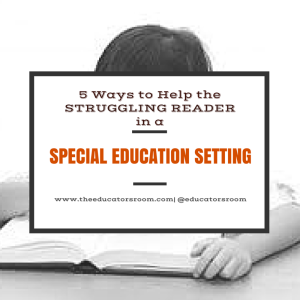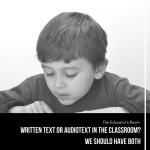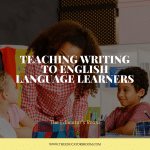 Everywhere you look, it seems a new program has sprung up to help the struggling reader in the classroom. More and more children, it seems, get referred for special education services because of reading deficits. So what can you do in the classroom to help? You could ask your RTI specialist, your special education teacher, or your school psychologist for a long list of strategies based on the area of need, but I’ll give you a good list of go-to strategies to start with, and you can head back later for more if you need them.
Everywhere you look, it seems a new program has sprung up to help the struggling reader in the classroom. More and more children, it seems, get referred for special education services because of reading deficits. So what can you do in the classroom to help? You could ask your RTI specialist, your special education teacher, or your school psychologist for a long list of strategies based on the area of need, but I’ll give you a good list of go-to strategies to start with, and you can head back later for more if you need them.
5 Strategies to Help the Struggling Reader
1. Choral Reading – reading aloud in unison with a whole class or group of students. Choral reading helps build students’ fluency, self-confidence, andmotivation. Because students are reading aloud together, students who may ordinarily feel self-conscious or nervous about reading aloud have built-in support. This strategy is recommended in place of round robin reading, where students each take turns reading, because every student reads at the same time and no one gets singled out.
* How do you use it? Choose a book or passage that works well for reading aloud as a group (predictable, patterned reading that’s not too long and that most students in the group can read independently).
* Make sure each student receives a copy of the text. You may choose to put a copy of the text on an overhead or place students at a computer monitor with the text on a screen.
* Model fluent reading for the students by reading aloud with them.
* Ask the students to use a marker, pencil, or finger to keep their spot as they read along in the passage.
* Reread the passage and have all students in the group read the story or passage aloud in unison.
To differentiate instruction, pair students of different abilities together and assign each student a different section of the passage to read. You can do this for your second language learner students, young learners, and students of varying levels.
2. Guided Oral Reading – another instructional strategy that can help students improve fluency. With this strategy, the teacher, parent, or peer reads a small part of the passage aloud, modeling fluent reading skills, then pauses and allows the student or class to read the same text aloud again, with encouragement and praise from the parent, teacher, or peer buddy.
3. Think-Alouds – described as “eavesdropping on someone’s thinking,” teachers use this strategy to verbalize aloud while reading a selection orally. Their verbalizations include describing things they’re doing as they read to monitor their comprehension. The think-aloud strategy models for students how skilled readers construct meaning from a text. Think-alouds help readers learn to monitor their own thinking as they read and monitor their own comprehension. It teaches students to re-read a sentence, read ahead to clarify, and/or look for context clues to make sense of what they read. In addition, slows down the reading process and allows students to watch their understanding of a text. To effectively use this strategy, make sure to model your thinking as you read, especially at points that may particularly confuse the students (new vocabulary, unusual sentence structure, etc.). Make sure to develop a set of questions ahead of time to support thinking aloud (e.g.; Do I understand what I have just read? Do I have a clear picture in my head of this information? etc.). Demonstrate how good readers monitor understanding by rereading sentences, reading ahead to clarify, and/or looking for context clues. Here is one Think-Aloud in Action!
4. Anticipation Guides – guides that help activate a student’s prior knowledge and peek the student’s curiosity about the topic. Before reading, students listen to or read several statements about key concepts presented in the text; they’re often given as a bunch of statements with which the students can choose to agree or disagree. Anticipation guides stimulate students’ interest in a topic and set a purpose for reading.
* When making an anticipation guide, especially for younger or lower level students, keep it as simple as possible. Include four to six statements about key ideas in the text; some true and some false. Add some columns following each statement, which can be left blank or labeled Yes, No, or Maybe. You could add a column for the students to revisit once they finish reading the text. You can find one template for an anticipation guide at this website.
* Model the process of using the anticipation guide with the students to ensure correct completion of the process. Read the statements and ask the students if they agree or disagree with them, providing them with an opportunity for discussion. Remember that you want to get the students interested in the topic and make predictions and that your focus at this time is not on the correct answers.
* Once finished with the reading, bring closure to it by revisiting the anticipation guide.
5. Paragraph Shrinking – an activity developed as part of the Peer-Assisted Learning Strategies (PALS) at the Vanderbilt Kennedy Center for Research on Human Development. This strategy allows each student to take turns reading, pausing, and summarizing the main points of each paragraph. Students provide each other with feedback as a way to monitor comprehension.
* To use paragraph shrinking, first choose the passage for the students to read, an introduce it to the students. identify ahead of time which children need help on specific skills and which children in the classroom would help them learn those skills most appropriately in order to create pairs within the classroom.
* Model the procedure to make sure students understand how to use the strategy and allow each member of the pair to take turns as “Coach” and “Player.” Each student should read aloud for 5 minutes without rereading a text and after each paragraph, students should stop and summarize the main points of the reading, with the following information as the focus:
– The who or what of the paragraph
– The most important thing about who or what
– The main idea
* If a “Player” ever gives a wrong answer, the “Coach” asks the “Player” to skim the paragraph again and answer the question a second time.
* Students should state the main idea in 10 words or less, which encourages them to monitor comprehension while taking turns reading. When the goals of the strategy are met, each pair gets awarded points. Watch this video to see a demonstration and download a blank template of paragraph shrinking cards here.
Hopefully these strategies will help your struggling readers, but please recognize that there’s no one-size-fits-all approach when it comes to students in the classroom. Continue to progress monitor your students, check with the specialists in your school if the strategies don’t work, and come up with creative solutions for the students that these strategies don’t reach. Your specialists know so many other strategies that will help your struggling readers.
What strategies have you used to help the students in your classroom that need that extra push?





